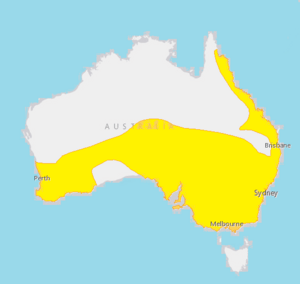Ozimops planiceps facts for kids
Quick facts for kids Ozimops planiceps |
|
|---|---|
| Conservation status | |
| Scientific classification | |
 |
|
| Where the southern free-tailed bat lives in Australia | |
| Synonyms | |
|
Nyctinomus planiceps Peters, 1866, Mormopterus planiceps |
The Ozimops planiceps, also known as the southern free-tailed bat, is a small bat. It belongs to the Molossidae family. These bats live in Australia and Indonesia.
Contents
About This Bat
Scientists have found it tricky to classify bats in the Mormopterus group. This bat was first described by Wilhelm Peters in 1881. Even then, people knew it was part of a group of very similar species.
Today, the most accepted description of this bat comes from research done in 2014. Sometimes, this bat is called 'Mormopterus Species 4'. This name usually refers to the southern free-tailed bat.
Common names for this bat include the little mastiff bat and the southern free-tailed bat.
What Does It Look Like?
It can be hard to tell this bat apart from others. Scientists often use special genetic tests to identify it.
Some physical features can help. These include the length of its forearm, its weight, and its color. The fur on its back and head is usually light brown to grey-brown. Its belly fur is lighter, often white at the bottom and light brown in the middle.
Other features include wrinkled lips and triangular ears. As its name suggests, its tail sticks out quite a bit past the tail membrane. You can also tell Ozimops planiceps apart by how its nostrils are spaced.
Where Does It Live?
The southern free-tailed bat lives in many parts of south-east Australia. This includes New South Wales, Victoria, and South Australia. It also lives in south-west Western Australia and along the east coast to Queensland. You can also find it in New Guinea.
These bats live in different types of places. They like mallee (a type of bushland), shrubland, and open forests. They prefer places that are wetter. They are good at living near cities and towns too.
Ozimops planiceps bats can sleep in tree hollows. They also use human-made spots like sheds and barns. They have not been found living in caves. A group of these bats can have up to 100 individuals. Female groups usually have 30-40 bats. Male groups are smaller, sometimes only 3-4 bats. These bats often share their roosts with other bat species.
What Do They Eat?
Like all Molossidae bats, the southern free-tailed bat eats insects. It uses echolocation to find its prey. This is like using sound waves to create a map of its surroundings.
They hunt for food in the open air, above trees, and in gaps between trees. They can even hunt near roads. These bats are agile. They can forage on the ground, but they might need to climb up a meter or two to take off again.
They eat many different insects. These include moths, various beetles, and Hymenoptera (like wasps and bees). What they eat depends on where they live. In Victoria, they have been seen eating the Rutherglen bug. This bug is a pest for farmers.
Reproduction
Female southern free-tailed bats usually have one baby each summer. They become pregnant from late winter to early spring. Females can have babies when they are about one year old.
Scientists have found that females can store sperm for up to two months. This helps them get pregnant at the best time. This ability is not known in other types of Molossidae bats. The exact time it takes for a baby bat to develop is not known.
Conservation
The IUCN says the southern free-tailed bat is a Least Concern species. This means it is not currently at high risk of disappearing. This is because it lives in many places and is quite common. However, in some areas, the number of these bats seems to be going down.
See also
 In Spanish: Mormopterus planiceps para niños
In Spanish: Mormopterus planiceps para niños


